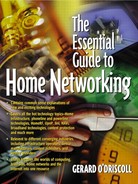SUMMARY
The six basic ideas of Jini were introduced in this chapter:
A community describes what happens when two or more devices using Jini technology come together to share their services. Jini software lets all devices work together, so you can create your own personal network or community any time, anywhere.
Jini devices receive their instructions through the network via a lookup server, a device that tracks all the Jini devices on a network and makes sure they can communicate with all the other devices.
Discovery is the process by which Jini in-home applications find the lookup services that serve their community.
Jini technology uses a mechanism called leasing to detect when a service becomes unavailable. When a device registers with the lookup service it receives a lease that it must periodically renew. If the lease is not renewed, then the lookup service removes the device from the list of services offered. Removing a device does not interrupt the state or services offered by the remaining members of the community.
Remote events are used by Jini to inform interested parties about changes that occur on a home network.
Transactions are an important tool for building reliable Jini-based home networks.
Jini has a number of benefits that improve productivity, cost savings, and ease-of-use for consumers. Jini technology source code is available at no cost to any licensee who wishes to evaluate it, improve it, repair it, and use it internally, as long as you adhere to the community guidelines outlined in the SCSL. The SCSL is a license model designed for distributing source code among the developer community. Toward the end of 1999, Sony and Sun announced plans to collaborate in bridging the technical divide between HAVi and Jini home networking architectures.
